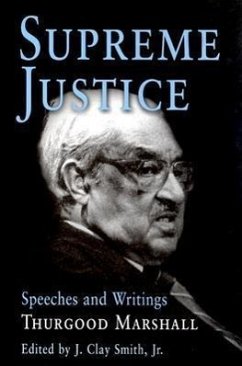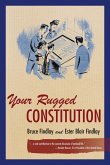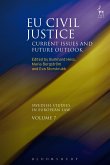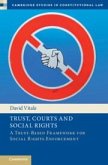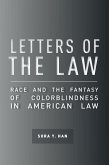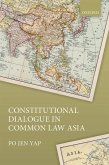- Gebundenes Buch
- Merkliste
- Auf die Merkliste
- Bewerten Bewerten
- Teilen
- Produkt teilen
- Produkterinnerung
- Produkterinnerung
"Supreme Justice" assembles the public presentations, occasional writings, speeches, and interviews of the late Supreme Court Justice Thurgood Marshall over a period of seven decades, from the 1930s to the 1990s. "With its deft selections drawn from throughout Marshall's storied career, this volume will appeal to students of legal history and the civil rights movement."--"Harvard Law Review"
Andere Kunden interessierten sich auch für
![Your Rugged Constitution Your Rugged Constitution]() Bruce Allyn FindlayYour Rugged Constitution16,99 €
Bruce Allyn FindlayYour Rugged Constitution16,99 €![EU Civil Justice EU Civil Justice]() EU Civil Justice115,99 €
EU Civil Justice115,99 €![Trust, Courts and Social Rights Trust, Courts and Social Rights]() David VitaleTrust, Courts and Social Rights114,99 €
David VitaleTrust, Courts and Social Rights114,99 €![Constitutional Debate in Action Constitutional Debate in Action]() H L PohlmanConstitutional Debate in Action143,99 €
H L PohlmanConstitutional Debate in Action143,99 €![Letters of the Law Letters of the Law]() Sora Y HanLetters of the Law105,99 €
Sora Y HanLetters of the Law105,99 €![The Future of Foreign Intelligence The Future of Foreign Intelligence]() Laura K DonohueThe Future of Foreign Intelligence33,99 €
Laura K DonohueThe Future of Foreign Intelligence33,99 €![Constitutional Dialogue in Common Law Asia Constitutional Dialogue in Common Law Asia]() Po Jen YapConstitutional Dialogue in Common Law Asia145,99 €
Po Jen YapConstitutional Dialogue in Common Law Asia145,99 €-
-
-
"Supreme Justice" assembles the public presentations, occasional writings, speeches, and interviews of the late Supreme Court Justice Thurgood Marshall over a period of seven decades, from the 1930s to the 1990s. "With its deft selections drawn from throughout Marshall's storied career, this volume will appeal to students of legal history and the civil rights movement."--"Harvard Law Review"
Hinweis: Dieser Artikel kann nur an eine deutsche Lieferadresse ausgeliefert werden.
Hinweis: Dieser Artikel kann nur an eine deutsche Lieferadresse ausgeliefert werden.
Produktdetails
- Produktdetails
- Verlag: University of Pennsylvania Press
- Seitenzahl: 360
- Erscheinungstermin: 31. Dezember 2002
- Englisch
- Abmessung: 238mm x 160mm x 32mm
- Gewicht: 708g
- ISBN-13: 9780812236903
- ISBN-10: 0812236904
- Artikelnr.: 22184772
- Herstellerkennzeichnung
- Libri GmbH
- Europaallee 1
- 36244 Bad Hersfeld
- gpsr@libri.de
- Verlag: University of Pennsylvania Press
- Seitenzahl: 360
- Erscheinungstermin: 31. Dezember 2002
- Englisch
- Abmessung: 238mm x 160mm x 32mm
- Gewicht: 708g
- ISBN-13: 9780812236903
- ISBN-10: 0812236904
- Artikelnr.: 22184772
- Herstellerkennzeichnung
- Libri GmbH
- Europaallee 1
- 36244 Bad Hersfeld
- gpsr@libri.de
J. Clay Smith, Jr. (1942-2018) was Professor of Law at Howard University and author of Emancipation: The Making of the Black Lawyer, 1844-1944, also available from the University of Pennsylvania Press.
Preface
Thurgood Marshall 1908-1993
PART I: THE LAWYER 1930s-1950s
The 1930s-1940s
Marshall and Houston Jailed (1932)
Letter to Dean Taylor Applying for Law School Position (1935)
The Gestapo in Detroit (1943)
Negro Status in Boilermaker Union (1944)
Saving the Race (1941)
The 1950s
From Law to Social Reality and Panel Discussion (1950)
Racial Integration in Education Through Resort to the Courts and Summit
Discussion (1952)
The Future Lies With Our Youth (1954)
Segregation and Desegregation (1954)
Interpretation of Supreme Court Decisions and the NAACP (1955)
Three Years After Brown I (1957)
The South on the Run (1957)
The Living Constitution: Civil Rights and the Negro (circa 1959)
Judicial Method in Due Process (1956)
The Rise and Collapse of the White Democratic Primary (1957)
Summary Justice: The Negro GI in Korea (1951)
Part II: SOLICITOR GENERAL, JUDGE, AND SUPREME COURT
JUSTICE, 1960s-1990s
The 1960s: Transition from Lawyer to Jurist
The United States as Moral Leader of the World (1961)
No Peace at Any Cost (1961)
The Courts (1964)
The Impact of the Constitution and Panel Discussion (1964)
Civil Rights in the United States (1966)
Remembering Lyndon B. Johnson and the Civil Rights Struggle (1969)
Group Action in the Pursuit of Justice (1969)
The 1970s
The Law Deals with a World of Individuals (1973)
Building a Tradition of Public Service (1976)
World Peace Through Law: An Urgent Task (1977)
Financing Public Interest Law Practice: The Role of The Organized Bar
(1975)
Who Is Best Qualified to Be a Judge? (1977)
Equality Before The Law; The Cardinal Principle of the Constitution (1978)
The Fulcrum of Pressure (1978)
The 1980s
Judicial Power and Respect for the People (1981)
Violations of the Constitution Require Corrective Relief (1984)
Moral and Fair Representation Issues in Death Penalty Cases (1985)
Charles Hamilton Houston (1987)
The Constitution: A Living Document (1987)
A Colorblind Society Remains an Aspiration (1987)
Right To Counsel (1988)
New Challenges Facing the Civil Rights Community (1989)
The 1990s
Looking Back (1992)
We Must Dissent (1992)
Appendix: The Fairness of the Reorganization Plan in Industrial
Corporations (1933)
Bibliography
Index
Acknowledgments
Thurgood Marshall 1908-1993
PART I: THE LAWYER 1930s-1950s
The 1930s-1940s
Marshall and Houston Jailed (1932)
Letter to Dean Taylor Applying for Law School Position (1935)
The Gestapo in Detroit (1943)
Negro Status in Boilermaker Union (1944)
Saving the Race (1941)
The 1950s
From Law to Social Reality and Panel Discussion (1950)
Racial Integration in Education Through Resort to the Courts and Summit
Discussion (1952)
The Future Lies With Our Youth (1954)
Segregation and Desegregation (1954)
Interpretation of Supreme Court Decisions and the NAACP (1955)
Three Years After Brown I (1957)
The South on the Run (1957)
The Living Constitution: Civil Rights and the Negro (circa 1959)
Judicial Method in Due Process (1956)
The Rise and Collapse of the White Democratic Primary (1957)
Summary Justice: The Negro GI in Korea (1951)
Part II: SOLICITOR GENERAL, JUDGE, AND SUPREME COURT
JUSTICE, 1960s-1990s
The 1960s: Transition from Lawyer to Jurist
The United States as Moral Leader of the World (1961)
No Peace at Any Cost (1961)
The Courts (1964)
The Impact of the Constitution and Panel Discussion (1964)
Civil Rights in the United States (1966)
Remembering Lyndon B. Johnson and the Civil Rights Struggle (1969)
Group Action in the Pursuit of Justice (1969)
The 1970s
The Law Deals with a World of Individuals (1973)
Building a Tradition of Public Service (1976)
World Peace Through Law: An Urgent Task (1977)
Financing Public Interest Law Practice: The Role of The Organized Bar
(1975)
Who Is Best Qualified to Be a Judge? (1977)
Equality Before The Law; The Cardinal Principle of the Constitution (1978)
The Fulcrum of Pressure (1978)
The 1980s
Judicial Power and Respect for the People (1981)
Violations of the Constitution Require Corrective Relief (1984)
Moral and Fair Representation Issues in Death Penalty Cases (1985)
Charles Hamilton Houston (1987)
The Constitution: A Living Document (1987)
A Colorblind Society Remains an Aspiration (1987)
Right To Counsel (1988)
New Challenges Facing the Civil Rights Community (1989)
The 1990s
Looking Back (1992)
We Must Dissent (1992)
Appendix: The Fairness of the Reorganization Plan in Industrial
Corporations (1933)
Bibliography
Index
Acknowledgments
Preface
Thurgood Marshall 1908-1993
PART I: THE LAWYER 1930s-1950s
The 1930s-1940s
Marshall and Houston Jailed (1932)
Letter to Dean Taylor Applying for Law School Position (1935)
The Gestapo in Detroit (1943)
Negro Status in Boilermaker Union (1944)
Saving the Race (1941)
The 1950s
From Law to Social Reality and Panel Discussion (1950)
Racial Integration in Education Through Resort to the Courts and Summit
Discussion (1952)
The Future Lies With Our Youth (1954)
Segregation and Desegregation (1954)
Interpretation of Supreme Court Decisions and the NAACP (1955)
Three Years After Brown I (1957)
The South on the Run (1957)
The Living Constitution: Civil Rights and the Negro (circa 1959)
Judicial Method in Due Process (1956)
The Rise and Collapse of the White Democratic Primary (1957)
Summary Justice: The Negro GI in Korea (1951)
Part II: SOLICITOR GENERAL, JUDGE, AND SUPREME COURT
JUSTICE, 1960s-1990s
The 1960s: Transition from Lawyer to Jurist
The United States as Moral Leader of the World (1961)
No Peace at Any Cost (1961)
The Courts (1964)
The Impact of the Constitution and Panel Discussion (1964)
Civil Rights in the United States (1966)
Remembering Lyndon B. Johnson and the Civil Rights Struggle (1969)
Group Action in the Pursuit of Justice (1969)
The 1970s
The Law Deals with a World of Individuals (1973)
Building a Tradition of Public Service (1976)
World Peace Through Law: An Urgent Task (1977)
Financing Public Interest Law Practice: The Role of The Organized Bar
(1975)
Who Is Best Qualified to Be a Judge? (1977)
Equality Before The Law; The Cardinal Principle of the Constitution (1978)
The Fulcrum of Pressure (1978)
The 1980s
Judicial Power and Respect for the People (1981)
Violations of the Constitution Require Corrective Relief (1984)
Moral and Fair Representation Issues in Death Penalty Cases (1985)
Charles Hamilton Houston (1987)
The Constitution: A Living Document (1987)
A Colorblind Society Remains an Aspiration (1987)
Right To Counsel (1988)
New Challenges Facing the Civil Rights Community (1989)
The 1990s
Looking Back (1992)
We Must Dissent (1992)
Appendix: The Fairness of the Reorganization Plan in Industrial
Corporations (1933)
Bibliography
Index
Acknowledgments
Thurgood Marshall 1908-1993
PART I: THE LAWYER 1930s-1950s
The 1930s-1940s
Marshall and Houston Jailed (1932)
Letter to Dean Taylor Applying for Law School Position (1935)
The Gestapo in Detroit (1943)
Negro Status in Boilermaker Union (1944)
Saving the Race (1941)
The 1950s
From Law to Social Reality and Panel Discussion (1950)
Racial Integration in Education Through Resort to the Courts and Summit
Discussion (1952)
The Future Lies With Our Youth (1954)
Segregation and Desegregation (1954)
Interpretation of Supreme Court Decisions and the NAACP (1955)
Three Years After Brown I (1957)
The South on the Run (1957)
The Living Constitution: Civil Rights and the Negro (circa 1959)
Judicial Method in Due Process (1956)
The Rise and Collapse of the White Democratic Primary (1957)
Summary Justice: The Negro GI in Korea (1951)
Part II: SOLICITOR GENERAL, JUDGE, AND SUPREME COURT
JUSTICE, 1960s-1990s
The 1960s: Transition from Lawyer to Jurist
The United States as Moral Leader of the World (1961)
No Peace at Any Cost (1961)
The Courts (1964)
The Impact of the Constitution and Panel Discussion (1964)
Civil Rights in the United States (1966)
Remembering Lyndon B. Johnson and the Civil Rights Struggle (1969)
Group Action in the Pursuit of Justice (1969)
The 1970s
The Law Deals with a World of Individuals (1973)
Building a Tradition of Public Service (1976)
World Peace Through Law: An Urgent Task (1977)
Financing Public Interest Law Practice: The Role of The Organized Bar
(1975)
Who Is Best Qualified to Be a Judge? (1977)
Equality Before The Law; The Cardinal Principle of the Constitution (1978)
The Fulcrum of Pressure (1978)
The 1980s
Judicial Power and Respect for the People (1981)
Violations of the Constitution Require Corrective Relief (1984)
Moral and Fair Representation Issues in Death Penalty Cases (1985)
Charles Hamilton Houston (1987)
The Constitution: A Living Document (1987)
A Colorblind Society Remains an Aspiration (1987)
Right To Counsel (1988)
New Challenges Facing the Civil Rights Community (1989)
The 1990s
Looking Back (1992)
We Must Dissent (1992)
Appendix: The Fairness of the Reorganization Plan in Industrial
Corporations (1933)
Bibliography
Index
Acknowledgments

